 It’s been boggling my mind.
It’s been boggling my mind.
I’ve spent more than a week wracking my brain.
Finally I decided to ask someone else.
I didn’t even have the question out of my mouth before I was laughing at myself for even having asked, knowing FULL-WELL the answer, “Andrew, what is it about cranberry sauce that no one really likes?.. oh duh! It’s CRANBERRIES!” My conclusion being that if you want to make a cranberry sauce that people will actually like, the first thing you need to do is scrap the cranberries. Hmm. That doesn’t really help in my quest to make a better cranberry sauce, now does it?
Most often, when I am interested in trying or creating a new dish I begin with a little research. I like to find out what the common (and uncommon) ingredients are for that dish, as well as the history of it’s use and a little about the culture that created or molded it into what we know today. In the case of cranberry sauce, was there a turning point that took something tasty and turned it into the sugary junk, or even worse -> jellied, canned, side dish that we see on our tables today? No. Not really.
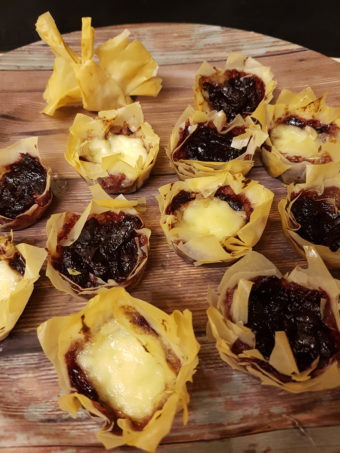 In searching for cranberry sauce recipes, commonality, and history I realized that it is, relativity, a very new dish. And very American. It was first introduced in 1912 and became a more popular option in 1941 after it became a regularly available canned good. Really this all tells me that it was a food created for our troops during the World Wars. When peace-times came and they needed to find a way to keep food on their own table the canning companies began advertising their goods to the common household. Convenience sells, right? We can thank this piece of history for the invention of TV dinners, Spam, and the likes, bringing about the creation of most, if not everything you have in your pantry and freezer.
In searching for cranberry sauce recipes, commonality, and history I realized that it is, relativity, a very new dish. And very American. It was first introduced in 1912 and became a more popular option in 1941 after it became a regularly available canned good. Really this all tells me that it was a food created for our troops during the World Wars. When peace-times came and they needed to find a way to keep food on their own table the canning companies began advertising their goods to the common household. Convenience sells, right? We can thank this piece of history for the invention of TV dinners, Spam, and the likes, bringing about the creation of most, if not everything you have in your pantry and freezer.
Maybe then we can understand why NO ONE serves cranberry sauce outside of Thanksgiving and Christmas. A mixture in a can designed to be a cheap source of vitamin C for troops does not equal a good recipe. And jellied? Sliding one of those cylinders out of a can and slicing it on a plate is about the same as squeezing the little squares of jelly out of the packages at a breakfast diner and serving them as a fresh fruit for Sunday brunch.
Now, I know many of you will say it tastes good. Of course! It might as well be pure sugar! But I beg of you, why can’t a cranberry sauce be more sophisticated?!
I want to make something that would be enjoyed outside of Thanksgiving and Christmas. Something that you would be proud to share at Girl’s Night In, a baby shower, or book club. A spread perhaps with a texture more worthy of a variety of baked goods. Yes! A spread! Now I am making progress.
Alright. So there must be some kind of sauce that is similar and actually gets served outside of Thanksgiving and Christmas, right? There’s got to be….
Come to find out, in Great Britain, there’s a redcurrent sauce that is eaten more often; along side Sunday roast dinner, with game, and of course the British Christmas dinner. Why can’t there be a sauce like this simply made from cranberries?
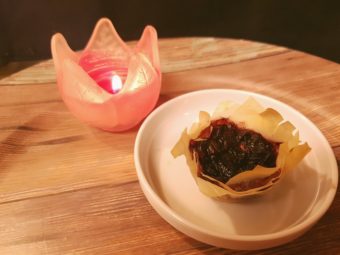
This would be a very nice dessert for a romantic date night.
As I’ve mentioned it several times, I’m really wanting to make a recipe that doesn’t rely so heavily on sugars to make it palatable. As a ‘more savory person’ I’m inclined to explore tangy ideas. Vinegar is definitely one of my favorite throw-ins to dishes, to add some depth and flavor, without adding a ton of calories. Although I did consider balsamic vinegar for an extra second, I really don’t think a vinegar is going to be the answer for the already intense flavor of the cranberries.
Now, looking along those lines I came across an intriguing sauce called verjuice. Although I didn’t actually use it in this recipe it did help in my planning.
All this talk of tang and grapes lead me to what I consider a grand idea. Mulled wine cranberry sauce! My first attempt was fantastic. The whole house smelled like a sweets shop, and the sauce was tangy and delicious! As always there are subtle changes to be made. First I switched to port instead of red wine. The natural sweetness of the port works well with the sour cranberries. ***And means I can add less sugar*** I also wanted to make sure that the wine was mulled with enough spices to really be tasted well in the cranberry spread. I tried increasing the amount of spices, but then I reduced the amount of wine from 2 cups to 1, to reduce the amount of time simmering, thinking the increased spices would do the deal. NOPE. I didn’t realize how much extra flavor was added by the reduction of the extra wine. I decided that the long simmer time was worth it and with purpose.
For me, the whole process for making this recipe is fantastic because you make the mulled wine/port, (recipe on this page) and use some in your cranberry sauce recipe, (also on this page) drink some of the mulled/port… and hopefully get to end result of actually baking the brie and filo treats using the cranberry spread. Happy day to me!
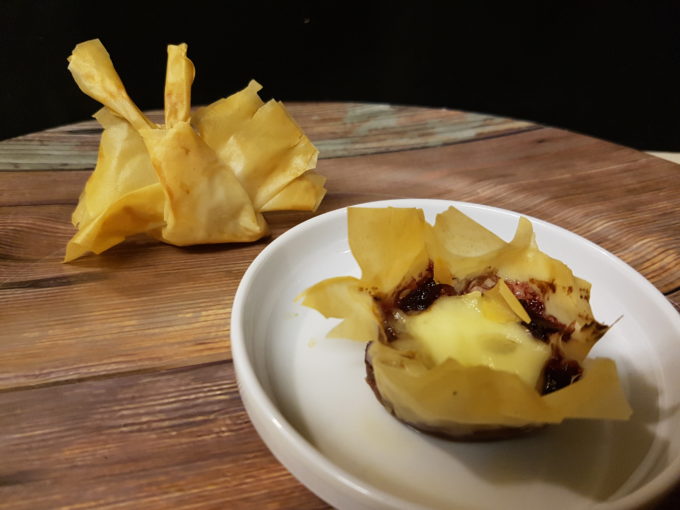
My attempt at a filo dough butterfly. It looks a little like a slug with wings.
By simply bookmarking this one page as “Holiday Recipes” you should have several areas of your festivities covered, any time you need them!
Basic Mulled Wine
By:vduley
Serves: 2-4
Ingredients:
- 1 bottle red wine
- 1 orange zested and sliced into rings
- 1/4 cup honey
- 6 whole cloves
- 8 cardamom pods
- 2 cinnimon sticks
- 2 whole star anise
- a large thumb size trimmed ginger – sliced
Directions:
- Very simple. Add the wine and spices to a medium pot over low heat for 30 minutes to 1 hour with a lid. You want to bring the wine to a simmer but not to a boil or you will boil off all the alcohol.Here are some other suggested options:
- The amount of ginger added can be adjusted to your liking; more if you really like ginger.
- I’ve also heard people take the ‘bulb’ off the top of the cloves to make them less intense.
- If you want your beverage to have some ‘punch’ you can add 1/2 a cup of brandy before simmering.
- OR – If it needs to be a little more family friendly add 1-4 cups of apple cider.
- Strain your liquid before serving. There are lots of fun ways to garnish: orange rings, star anise, cinnamon stick ‘straws.’ Have fun! Enjoy, but remember to enjoy responsibly.
Mulled Port for use in Cranberry Sauce
By:vduley
Serves: varies
Ingredients:
- 2 cups port
- 1 orange zested and sliced into rings
- 1/4 cup honey
- 6 whole cloves
- 8 cardamom pods
- 2 cinnimon sticks
- 2 whole star anise
- a large thumb size trimmed ginger – sliced
Directions:
- By adding the port and spices to a pot and simmering, you will get an intensely mulled port. It is intended for use in the cranberry sauce. Simmer for 30 minutes to 1 hour with a lid.
- Strain your mulled port.
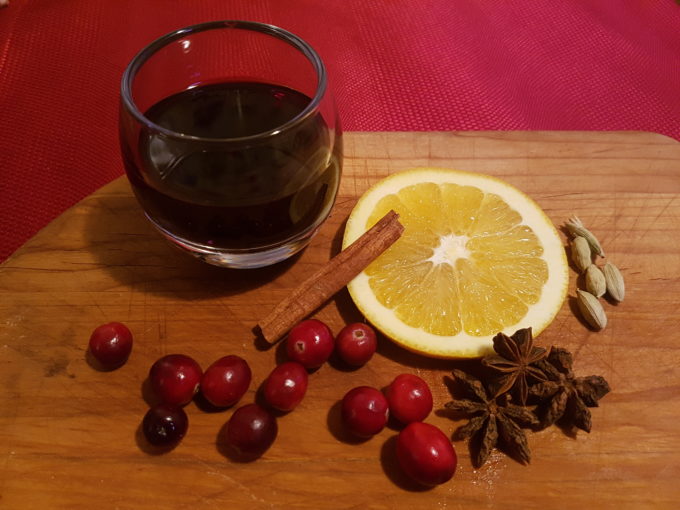
Mulled Port/Wine Cranberry Sauce
By:vduley
Serves: varies
Ingredients:
- ~2 cups mulled port – from recipe above
- OR 2 cups typical mulled wine
- 1 pound bag of cranberries
- 1/2 to 1 cup honey – personal preference
- mulled orange peels – fine chopped – (optional)
Directions:
- Again, very simple. Add the mulled port and cranberries to a small sauce pan. Bring to a simmer over medium-low heat, reduce to low and let the sauce reduce. The cranberries will become soft and ‘pop.’ Your sauce will thicken to a jelly-like spread. It’s going to take a while, atleast an hour. Feel free to add more honey to your personal liking.
NOTE: I suggest saving the orange peels from the mulling process, chopping them small, and adding to your cranberry and port/wine reduction. This will bring more texture and flavor depth. But I also understand that not everyone likes that texture and flavor, such as is found in marmalade.
Mulled Port Cranberry Sauce and Brie in Filo Cups
By:vduley
Serves: 36 Pieces
Ingredients:
- Mulled Port Cranberry Sauce (recipe above)
- Filo Dough
- Melted Butter
- 2 Brie Wedges or 1 Wheel of Brie
Directions:
- Spray your mini muffin tin pan with non-stick spray and preheat the oven to 350 degrees.
- Roll out your thawed filo sheets and cut into 3×3 inch squares. You will need 3 squares for each cup.
- When you are assembling the cups be sure to work in small batches covering the remaining dough with plastic (or re rolling) and a damp towel. It really does only take about 5 minutes for these paper thin sheets to dry-out and become unsuitably brittle.
- To assemble the filo cups: Brush each sheet with melted butter, laying them staggered in stacks of three. (They should look something like an eight-sided star.) Gently press each set of sheets into a cup, folding into a circle as needed. The corners will stick up over the edge of the tins.
- Cut 1 inch cubes or brie for each cup. You can assemble them cheese first or Cranberry Sauce first. Both are tasty. For presentation the melted brie on top with the warm cranberry coming up and surrounding looks quite nice, but I do agree with many others that having the brie on the bottoms leads to a wonderful buttery surprise when eating. A presentation of both ways is always a solution. However you choose to load them, you don’t need to fill above the rim.
- Bake for 10-15 minutes. Look for melted brie and golden filo dough. To remove from tins gently scoop out with a spoon.
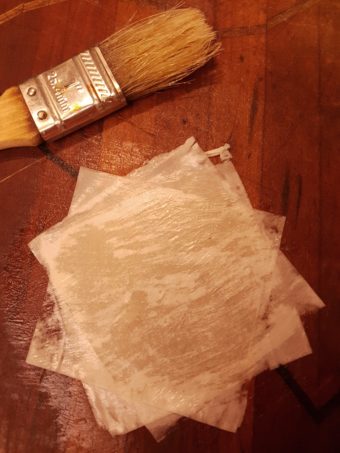


Post a comment